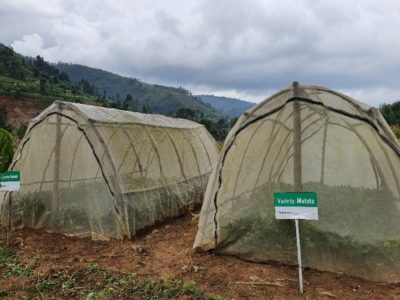Sweetpotato seed systems, which produce and distribute vine cuttings that farmers plant, are vital for disseminating improved varieties and ensuring that farmers have access to sufficient quality planting material when they need it. The International Potato Center (CIP) and partners have worked to strengthen sweetpotato seed systems in sub-Saharan Africa as part of efforts to get more families growing nutritious and high-yielding varieties. However, the rural vine multipliers who form an important link in a sweetpotato seed system face challenges in building a large base of reliable customers, to ensure the sustainability of their business. The use of market segmentation to increase and maintain their customer base can help seed producers prosper, and ensure sustainable pathways for delivering quality planting material to the smallholder farmers who need it.
Sweetpotato seed systems are characterized by varied actors including institutional or private sector producers of disease-free vines, rural vine multipliers, farmers, institutional customers, extension officers, researchers and policy makers. The number and type of actors depends on how dynamic a seed system is. For instance, informal seed systems, which are predominant in most sub-Saharan Africa countries, are characterized by farmer-to-farmer exchange and farmers saving planting material from the previous crop. Formal systems are better organized, producing large quantities of quality vines of improved varieties, which result in better harvests for the farmers who plant them.
To gain insight on this issue, a group of researchers from East Africa visited the KOTEMU farmer group in Muhanga District, Rwanda on February 21, as part of a learning journey supported by the Sweetpotato Genetic Advances and Innovative Seed Systems (SweetGAINS) project, led by CIP. KOTEMU is a well-organized group established in 2008 that is part of Urugaga Imbaraga, a national farmer organization that works to improve the socio-economic conditions of an estimated 27,300 farmers in 25 of Rwanda’s 30 districts.
KOTEMU’s members began sweetpotato seed multiplication after learning that it was a profitable venture, and the group currently produces about 10 tons of sweetpotato vines per year. They obtain virus-free starter material from the Rwanda Agriculture and Animal Resources Development Board (RAB) once every three years. The group grows that starter material in net tunnels, which protect plants from the virus vectors (such as white flies) and regularly harvest vine cuttings for planting in open fields at 20 cm x 10 cm spacing, for rapid multiplication. After three multiplication cycles in the field, vines are sold. In addition, members get small quantities to multiply on their own farms, because KOTEMU group has land shortage.

KOTEMU sells vine cutting to two types of customers: institutional customers and smallholder farmers. The main customers are NGOs with nutrition-focused projects, which buy planting material for orange-fleshed sweetpotato (OFSP) varieties for distribution to smallholder farmers. Individual smallholders also source planting material from KOTEMU, but they don’t pay for it. In rural Rwandan culture, farmers don’t sell planting material to neighbors, rather they exchange seed of one crop for that of another. The group consequently mainly produces for the NGO market. However, this is not sustainable since it is dependent on nutrition-focused projects which are often short-lived. For example, whereas KOTEMU had a reliable market in the last two years at a price of RWF 400 per kg, demand has since dropped, and the selling price is now RWF 125 per kg. The group adapts to changing market dynamics by scaling its production up or down depending on demand.
Market segmentation can help sweetpotato seed producers like KOTEMU to enhance the profitability of their businesses. This entails dividing a target market into smaller, more defined groups that share similar characteristics such as demographics, needs or location. Segmenting enables one to cater to the needs of a specific client and increases efficiency of communication through targeted messages. As in Rwanda, the main clients for sweetpotato planting material across sub-Saharan Africa are NGOs, local governments and smallholder farmers. These have different characteristics: for example, NGOs usually buy huge volumes of OFSP whereas smallholder farmers want small quantities of mostly white-fleshed varieties.
The table below describes the common categories of sweetpotato seed customers in Africa.
| Market category/ segment | Description |
| Non-governmental organizations (NGOs) | NGOs promoting adoption of OFSP varieties to combat vitamin A deficiency purchase quality planting material for free distribution to farmers. They pay good prices and organize transport. |
| Commercial farmers | Mid-sized farmers who produce sweetpotato for sale prefer to use quality planting material and are willing to pay for it. They arrange transportation. |
| Traders/vine vendors | Brokers who buy vines and sell to farmers in other areas usually buy at low prices to maximize their profits. |
| Smallholder farmers | Mainly subsistence farmers and few are willing to pay for vines. They acquire a few vines – mostly white-fleshed varieties – and multiply them for planting. |
| Schools, e.g. primary and secondary | Some schools have incorporated orange-fleshed sweetpotato into feeding program. They have adequate land, manpower and other resources for farming. |
| Local governments
|
In some countries, district councils or municipalities set aside funds to purchase quality planting material for free distribution. |
| Other seed producers | Seed producers can buy starter material from their counterparts for further multiplication. |
Understanding the needs of different customers enables producers to plan seed production, i.e. what amount of which varieties to produce. When there is high demand from NGOs, they’ll want to increase production of OFSP varieties, but high demand from smallholder farmers implies production of white and yellow-fleshed varieties with high dry matter content. By adopting market segmentation, sweetpotato seed producers can increase the resilience of their enterprise, which can ensure sustainable incomes for producers and a supply of quality planting material for institutions and farmers.
Blog by Kwame Ogero, Virus Degeneration Study Regional Research Associate at CIP.
